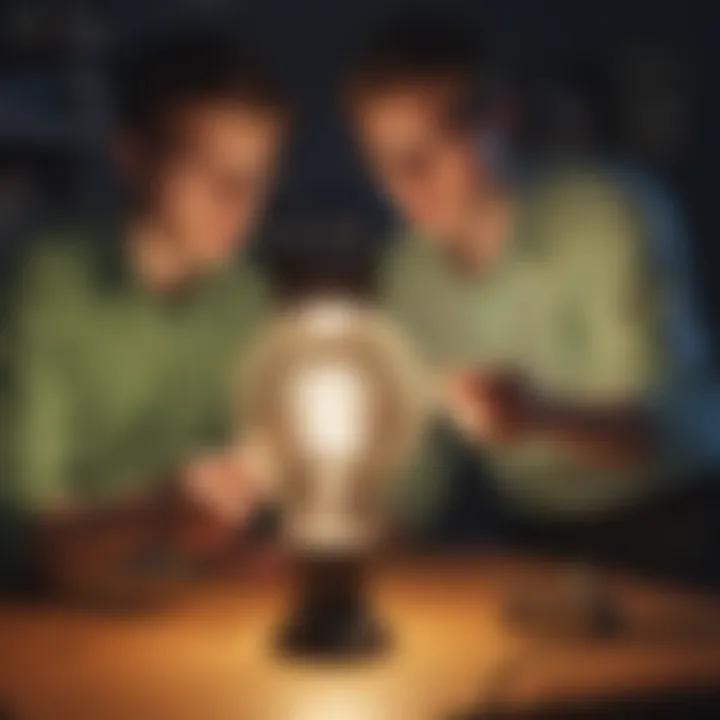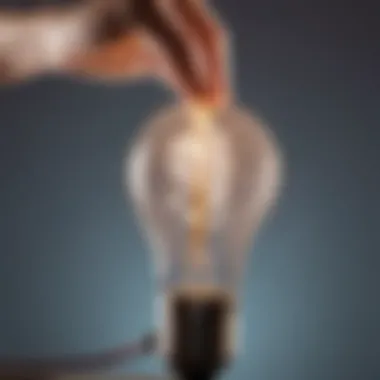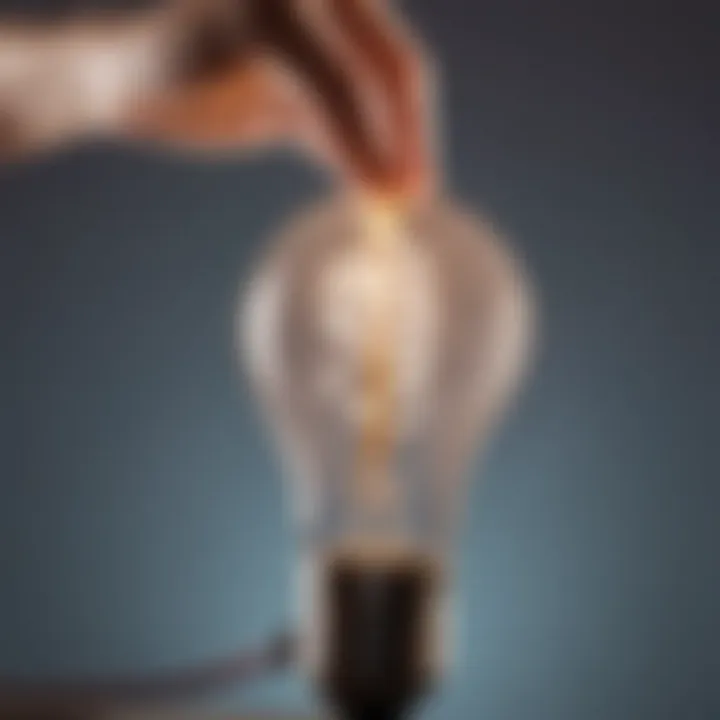Engage Young Minds with Light Bulb Science Experiments for Curious Kids


Science Fun Facts
Did you know that the first modern incandescent light bulb was invented by Thomas Edison in 1879? This groundbreaking invention revolutionized the way we illuminate our world and paved the way for further advancements in lighting technology. Understanding the science behind how light bulbs work can be both fascinating and enlightening for young science enthusiasts.
Discover the Wonders of Science
Exploring Various Scientific Concepts
Light bulbs may seem like simple objects, but they operate based on complex scientific principles. By delving into the inner workings of a light bulb, children can learn about electricity flow, filament resistance, and the conversion of electrical energy into light. Through hands-on experiments, they can grasp these concepts in a tangible and interactive way. Educational Videos and Animations
To complement the practical experiments, educational videos and animations can provide visual aids to enhance understanding. By watching how electricity flows through a circuit to illuminate a light bulb or seeing the different components of a bulb in action, young learners can reinforce their theoretical knowledge with real-world examples. Interactive Learning Tools
Interactive learning tools such as online simulations or virtual experiments can further engage children in the science behind light bulbs. These tools allow them to manipulate variables, observe outcomes, and deepen their comprehension of concepts like conductivity, resistance, and circuitry. Real-Life Applications of Science
Understanding the science of light bulbs also presents opportunities to explore real-life applications. From the evolution of lighting technology to the impact of energy-efficient bulbs on the environment, children can connect scientific principles to daily experiences and societal trends.
Science Quiz Time
Interactive Quizzes
Test your knowledge with interactive quizzes that challenge understanding of light bulb science. From questions about circuit components to inquiries on energy efficiency, quizzes can reinforce learning outcomes and spark curiosity in young minds. Multiple Choice Questions
Engaging multiple-choice questions offer varied options to assess comprehension and critical thinking skills. By selecting the correct answers related to light bulb science, children can solidify their understanding while enjoying a playful assessment format. Brain Teasers and Puzzles
Brain teasers and puzzles related to light bulbs can stimulate problem-solving abilities and promote a deeper interest in science. Encouraging children to think creatively and logically, these challenging activities contribute to an enjoyable learning experience. Learning Through Gamification
Gamifying science education through light bulb-themed games can make learning more entertaining and effective. By incorporating elements of competition, rewards, and exploration, gamification motivates young learners to engage with scientific concepts in a fun and interactive manner.
Science Experiment Showcase
Fun and Engaging Experiments
Embark on a journey of discovery with fun and engaging light bulb science experiments. From constructing simple circuits to observing the effects of different filaments, these hands-on activities encourage exploration and experimentation.
Step-by-Step Instructions
Follow detailed step-by-step instructions to conduct light bulb experiments safely and effectively. From gathering materials to setting up the experiment, clear guidelines ensure a seamless learning experience for children and facilitators. Materials List


Prepare for exciting experiments by checking the required materials list, including batteries, wires, light bulbs, and safety goggles. Having all items on hand beforehand allows for smooth execution of the experiments and promotes a safe learning environment. Safety Tips and Precautions
Prioritize safety during light bulb experiments by following essential guidelines and precautions. From handling electrical components with care to supervising children throughout the experiments, ensuring a secure environment is paramount for a positive and educational experience.
Introduction to Light Bulb Science Experiments
In this segment of the article, we delve into the fundamental essence of light bulb science experimentation, a cornerstone for igniting scientific curiosity in young enthusiasts. Understanding the basics of light bulbs is not merely about illumination; it is about grasping the very essence of how light and energy intertwine. By unraveling the intriguing history of light bulbs, exploring the diverse types available, and delving into the intricate workings behind illumination, we pave the way for a deeper comprehension of the world of science through practical exploration.
Understanding the Basics of Light Bulbs
History of Light Bulbs
The history of light bulbs traces back through a myriad of technological advancements that have revolutionized modern society. Examining the evolution of lighting instruments offers a unique portal into the progression of human ingenuity, from humble beginnings to the cutting-edge innovations of today. Understanding the intricate timeline of light bulb development not only provides insight into past achievements but also inspires future inventors to push the boundaries of scientific exploration.
Types of Light Bulbs
Expanding our horizon to encompass the vast array of light bulb options available is pivotal in crafting a comprehensive grasp of lighting technology. From classic incandescent bulbs to energy-efficient LEDs and compact fluorescents, each type possesses distinct characteristics that cater to specific needs and preferences. Identifying the unique features and functionalities of different light bulb types empowers young minds to make informed choices and leads to a more profound understanding of energy consumption and environmental impact.
How Light Bulbs Work
Unraveling the enigma behind how light bulbs operate delves into the realms of electrical engineering and scientific innovation. Understanding the intricate processes that transmute electrical energy into radiant light reveals the fascinating interplay between electrical currents and luminous output. By comprehending the inner workings of light bulbs, budding scientists can grasp essential principles of energy conversion and pave the way for innovative scientific exploration.
Safety Measures for Conducting Experiments
To embark on a scientific journey safely and effectively, it is paramount to emphasize stringent safety protocols. From instilling a culture of diligence through safety precautions to the indispensable role of adult supervision in experimental settings, ensuring proper equipment handling is vital to a fruitful scientific venture.
Safety Precautions
Prioritizing safety through meticulous precautions is non-negotiable when engaging in light bulb experiments. Understanding and implementing safety guidelines mitigate risks and promote a secure environment for exploration. By instilling responsible safety practices, we cultivate a culture of scientific inquiry imbued with caution and consciousness.
Adult Supervision
The presence of knowledgeable adults to oversee scientific experiments is indispensable in fostering a safe and enriching environment for young learners. Adult supervision not only ensures adherence to safety protocols but also provides guidance and mentorship, nurturing a sense of curiosity and responsibility in budding scientists. By engaging in experiments under adult supervision, children are encouraged to explore the wonders of science in a secure and supportive setting.
Proper Equipment Handling
Efficient and proper handling of scientific equipment is a foundational skill that underpins successful experimentation. Teaching young enthusiasts the significance of equipment care and usage fosters a culture of responsibility and precision. By mastering the art of proper equipment handling, children develop essential scientific skills and lay the groundwork for future scientific endeavors.


Introduction to Science Concepts
Venturing into the realm of science concepts opens doors to a world of discovery and enlightenment, guiding young minds through the intricacies of electricity, conductivity, and energy conversion. These foundational principles not only illuminate the path towards scientific understanding but also spark curiosity and creativity in aspiring scientists.
Electricity and Circuits
Navigating the realm of electricity and circuits unveils the backbone of many technological marvels that define our modern age. Understanding the flow of electrons through conductive pathways and witnessing the transformation of electrical energy into usable power broadens one's perspective on energy distribution and utilization. By grasping the fundamentals of electricity and circuits, young learners cultivate a profound appreciation for the inner workings of electronic devices and systems.
Conductivity
Exploring the concept of conductivity leads young enthusiasts into the realm of material science and electrical engineering. By discerning the varying degrees of material conductivity and comprehending the factors that influence electron flow, children gain valuable insights into the properties of different substances. Through hands-on experiments that investigate conductivity, budding scientists hone their analytical skills and deepen their understanding of material composition and behavior.
Energy Conversion
Delving into the intricacies of energy conversion bridges the gap between theoretical knowledge and practical application. Witnessing the transformation of energy from one form to another underscores the fundamental laws of physics and thermodynamics. By engaging in experiments that dissect energy conversion processes, young minds develop a holistic understanding of energy transfer mechanisms and cultivate an appreciation for sustainable energy practices.
Fun and Educational Light Bulb Experiments
Light bulb experiments serve as a fascinating educational tool in this article, engaging young science enthusiasts in a hands-on learning experience that combines fun with knowledge. These experiments are meticulously selected to offer a comprehensive understanding of the underlying scientific principles related to electricity and conductivity. By actively participating in these experiments, children aged 6-12 can enhance their curiosity and critical thinking skills, laying a strong foundation for future scientific explorations.
Experiment 1: Building a Simple Circuit
Materials Needed
The core components required for this experiment include a battery, wires, a light bulb, and a switch. Each element plays a crucial role in constructing a functional circuit to illuminate the light bulb. The battery acts as the power source, providing the necessary electrical energy to activate the light bulb. Wires serve as conductors, facilitating the flow of electricity between the battery, switch, and light bulb. The light bulb, when connected correctly, transforms electrical energy into light. The switch controls the circuit's completion, allowing users to turn the light on and off conveniently.
Step-by-Step Instructions
To construct a simple circuit, start by connecting one end of a wire to the battery's positive terminal. Then, attach the other end of the wire to one terminal of the light bulb. Subsequently, connect a second wire from the light bulb's other terminal to the battery's negative terminal, completing the circuit. Finally, introduce the switch into the circuit by inserting it on either the positive or negative wire, allowing for easy control of the light bulb's illumination.
Observations and Results
Upon completing the circuit, observe the light bulb lighting up when the switch is closed, indicating a continuous flow of electricity through the circuit. Experiment with opening and closing the switch to comprehend its impact on the circuit's functionality. Document any variations observed in the light bulb's brightness or behavior when altering the circuit's configuration, providing insights into the principles of circuitry and electrical connections.
Experiment 2: Testing Conductivity with Light Bulbs
Hypothesis Formulation


Prior to conducting the experiment, formulate a hypothesis concerning the conductivity levels of different materials when incorporated into the circuit. Predict the behavior of materials such as metal, plastic, and wood in conducting electricity based on their known properties and composition. Consider factors like resistance and material structure in shaping your hypothesis.
Experimental Setup
Create a test setup that allows for the insertion of various materials between the circuit components to test their conductivity. Prepare samples of different materials and carefully place them in the circuit to assess their impact on the flow of electricity. Observe how each material influences the brightness and stability of the light bulb, providing valuable insights into the materials' conductivity properties.
Data Collection and Analysis
During the experiment, record the conductivity levels exhibited by each material in the circuit, noting any differences in the light bulb's behavior. Analyze the data collected to draw comparisons between the conductivity of different materials, identifying trends and patterns. Reflect on the role of conductivity in electrical circuits and its significance in various applications requiring efficient energy transfer.
Experiment 3: Exploring Energy Efficiency
Variable Factors
Explore the impact of variable factors such as battery power, wire thickness, and circuit complexity on the energy efficiency of the light bulb circuit. Alter these variables systematically to observe their influence on energy consumption and light output. Compare the performance of the circuit under different configurations to understand the relationship between energy input and output efficiency.
Comparative Analysis
Conduct a comparative analysis of the energy efficiency achieved in various circuit setups, highlighting the most effective configurations in terms of light bulb brightness and battery longevity. Consider aspects like power loss, heat generation, and resource utilization in evaluating the efficiency of each circuit arrangement. Draw connections between energy conservation practices and the design of efficient electrical circuits.
Conclusion
Interactive Learning and Beyond This section delves into the crucial aspects of interactive learning and its significance within the context of this article aimed at young science enthusiasts. Interactive learning offers a dynamic and engaging approach to education, allowing children to actively participate and explore scientific concepts in a hands-on manner. By incorporating interactive elements into science education, young learners can not only grasp theoretical knowledge but also experience practical applications, fostering a deeper understanding of complex scientific principles. Interactive learning encourages curiosity, critical thinking, and problem-solving skills, essential for nurturing young minds towards a future in STEM disciplines. Through interactive methods, children can develop a passion for science that extends beyond textbooks, promoting a lifelong interest in discovery and learning. Considering the benefits of interactive learning, this article emphasizes the importance of engaging young learners through immersive and participatory educational experiences.
Online Resources for Further Exploration
Websites for Science Activities Websites dedicated to science activities play a vital role in supplementing traditional education by providing a platform for interactive learning outside the classroom. These websites offer a diverse range of science-themed activities, experiments, and resources that cater to different age groups and educational levels. A key characteristic of these websites is their user-friendly interface, which simplifies navigation and facilitates access to a wealth of science-based content. Children can engage with interactive simulations, virtual experiments, and educational games that make learning about science both informative and entertaining. The unique feature of websites for science activities lies in their ability to make complex scientific concepts accessible and engaging through multimedia elements and interactive tools. While these platforms offer a convenient way for young learners to explore science at their own pace, potential disadvantages may include the need for reliable internet access and adequate parental guidance to ensure safe online exploration. Nonetheless, websites for science activities remain a beneficial and popular choice for enriching the educational experience of young science enthusiasts. Educational Apps Educational apps designed for science education contribute significantly to the immersive learning experience outlined in this article. These apps leverage technology to deliver interactive lessons, quizzes, and hands-on experiments that supplement traditional classroom instruction. A key characteristic of educational apps is their adaptability, allowing children to learn at their own pace and receive personalized feedback on their progress. Educational apps serve as convenient tools for integrating science learning into everyday routines, providing access to a wide range of educational content on mobile devices. The unique feature of educational apps lies in their ability to create engaging learning environments that cater to various learning styles and preferences. While educational apps offer many advantages, such as accessibility and interactivity, some considerations include the need for careful selection to ensure the app aligns with educational objectives and offers accurate content. Overall, educational apps play a vital role in enhancing the learning experience for young science enthusiasts, making them a valuable asset in the exploration of scientific concepts. Virtual Science Labs Virtual science labs represent a revolutionary approach to hands-on science education in the digital age, offering immersive and interactive laboratory experiences that parallel real-world experiments. These virtual labs allow students to conduct experiments, analyze data, and draw conclusions in a simulated environment, providing a safe and cost-effective alternative to traditional laboratory settings. A key characteristic of virtual science labs is their ability to replicate authentic scientific processes and phenomena, enabling students to engage in practical science activities from any location. The immersive nature of virtual labs enhances student engagement and comprehension by presenting scientific concepts in a dynamic and visually compelling format. The unique feature of virtual science labs is their capacity to accommodate a diverse range of experiments and simulations, catering to various scientific disciplines and educational levels. Despite their numerous advantages, virtual science labs may require additional resources for implementation, such as compatible hardware and software, and may lack the tactile experience of traditional laboratory settings. Nevertheless, virtual science labs offer a valuable opportunity for young learners to explore scientific concepts in a dynamic and interactive manner, making them a beneficial choice for enriching the science learning experience.
Conclusion
Concluding this enlightening journey through light bulb science experiments for young science enthusiasts is crucial for reinforcing the essence of hands-on learning and scientific exploration at a tender age. By immersing children in the captivating world of experimentation, we ignite a passion for understanding the fascinating realm of electricity and conductivity. This hands-on approach not only cultivates a deep understanding of scientific principles but also nurtures essential skills such as critical thinking and problem-solving. Through these engaging experiments, children not only grasp theoretical concepts but also apply them practically, fostering a holistic learning experience that leaves a lasting impact on their budding intellects.
Inspiring Young Minds Through Science Exploration
Importance of Hands-On Learning
Highlighting the pivotal role of hands-on learning in this article sheds light on its fundamental contribution to igniting curiosity and instilling a love for scientific inquiry. The interactive nature of hands-on experiments allows children to directly engage with scientific concepts, making theoretical ideas tangible and relatable. This approach not only enhances comprehension but also sparks creativity and encourages active participation. The hands-on learning experience enables children to develop problem-solving skills, analytical thinking, and a genuine appreciation for the scientific method, shaping them into inquisitive learners with a profound understanding of the world around them.
Nurturing a Scientific Mindset
Delving into the significance of nurturing a scientific mindset in young individuals underscores the importance of fostering a curiosity-driven approach to learning. By instilling a sense of wonder and exploration, children are encouraged to question, hypothesize, and experiment, laying the foundation for a lifelong pursuit of knowledge. Nurturing a scientific mindset not only cultivates a passion for discovery but also cultivates skills such as observation, inference, and evaluation. This mindset empowers children to approach challenges with a scientific lens, fostering resilience, adaptability, and a growth mindset essential for navigating the complexities of the modern world.
Future Implications
Exploring the future implications of engaging in light bulb science experiments unveils a spectrum of possibilities for young minds embarking on a journey of scientific discovery. By nurturing a passion for science early on, children are equipped with essential skills and competencies that transcend the realm of academia. A deep-rooted interest in scientific exploration paves the way for future innovation, inspiring young individuals to pursue careers in STEM fields and contribute significantly to society. Moreover, instilling a scientific mindset from a young age prepares children to tackle real-world challenges, fostering a generation of critical thinkers, problem solvers, and innovators poised to shape the future landscape of science and technology.







